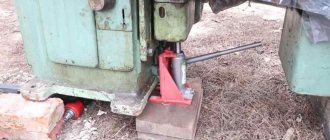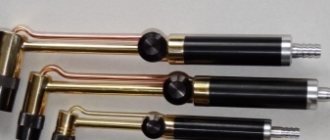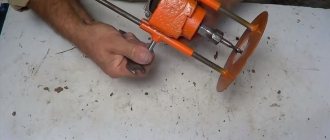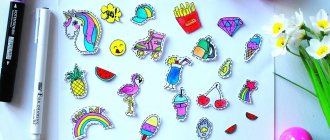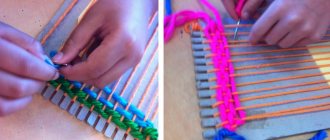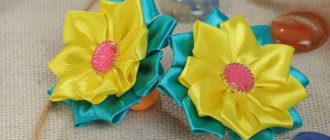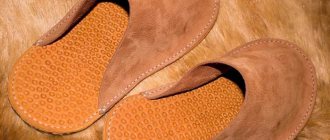The technology of manual metal processing goes back thousands of years. There are two main types. This is cold or hot forging. To process metal using the hot method, you need a forge or melting furnace and a properly prepared room. And the price for these devices is high.
Cold forging equipment can be placed in any suitable location, such as a home extension. If desired, some of the machines can be made independently. This circumstance significantly reduces the costs of organizing production. In addition, photos of the machines are easy to find on the Internet.
Cold forging machines: advantages of their use
The main advantage is that it is quite easy to make a cold forging machine with your own hands. And also, if necessary, you can do without electric drives.
In addition, working on such machines has the following advantages:
- fast learning;
- ease of operation;
- low labor costs;
- possibility of producing a series of parts;
- creating unique designs by combining basic elements;
- safety.
What kind of devices are used?
Cold forging is characterized by various curls, bends, twisted rods, etc. Almost every type is made on a separate device - a specific machine. They can be driven manually or electrically. For small volumes “for yourself”, manual cold forging machines are used. Although they are not particularly productive, they are much easier to manufacture. If it is necessary to put production on stream, similar devices are made, but with electric motors. In this case, there is almost no need to physically work, but the complexity of making the device increases significantly. In our material we will talk about manual machines for cold forging.
What devices are used:
- Torsion bars. With their help, tetrahedral rods or strips of metal are twisted in the longitudinal direction. The result is twisted columns, which are also called torsion bars.
This is what a torsion bar and the machine of the same name look like - Flashlight. On this device, the rod is also twisted in the longitudinal direction, but it is also additionally bent in the transverse direction. It turns out something similar to a flashlight. Hence the name of the device.
This is how they make a flashlight - Twisters or snails. Form flat curls of different diameters.
Device for cold forging snail - for forming curls - Bending machines or benders. Allows you to bend rods or reinforcement at the required angle anywhere.
For bending anywhere and at any angle - bending machines (bending machines) - Wave. In fact, this is also a bend, but of a more complex design - it allows you to change the direction of bending, obtaining wavy parts.
Machine "Volna" - for the formation of the appropriate relief - Devices for processing the ends of parts - inertial stamping machines or other home-made devices.
Machines for shaping the ends of rods. In this case - crow's foot
For a beginning craftsman, the most relevant machine for cold forging is a snail. Only with its help you can make many interesting things - from a fence and gate to a bench and other similar products. In second place in terms of necessity is a torsion bar machine. It adds variety to the details. All the rest can be purchased or made as you improve and gain skill.
Types of machines
There are several main types of machines used in cold forging of metal:
- snail;
- torsion bar machine;
- gnutik;
- wave;
- press.
This is the minimum set of machines to start working with workpieces. And also you won’t be able to do without an angle grinder (angle grinder) and a welding machine.
In addition, devices such as a globe, a flashlight or a volumetric volume are often used in production.
Machine tools as an alternative to tools
If you plan to organize home production, and not perform one-time work, it is best to purchase a combined machine for cold forging. It will take up significantly less space than the equipment separately.
Most models have an electric drive, which speeds up the production process. Contents and functionality depend on requirements. The average cost of such equipment is from 60,000 rubles.
Which machines are the most important?
Almost all fixtures used in the cold forging process are installed on the two main machines as add-ons.
A globe, flex or volumetric tube is placed on the base of the cochlea.
The flashlight device is mounted on a torsion bar machine.
Device for bending metal elements “Snail”
Do-it-yourself cold forging is impossible without the use of this machine. It is used to make rounded patterns from a profile pipe or rod. The resulting pattern elements are curls or volutes.
The workpiece is shaped by winding it onto a template using hands or levers.
In more complex designs, the workpiece is bent using a jig attached to the shaft axis.
You can buy such a machine or make it yourself.
How to make a tin scoop with your own hands
How to make a tin dustpan with your own hands, the necessary equipment for cleaning premises. An inexpensive homemade item will bring a lot of positive emotions while using it.
Consider a design consisting of only two parts:
• scoop bucket • handle
Let's cut out the figure shown in the figure from galvanized sheet steel GOST 14918-80
The dotted line shows the places of bends, their radii, directions and angles. Punch holes in the teeth or drill them with a drill. We bend the metal along the bend lines on the beam and beat it with a mallet (a flat wooden hammer) and get a scoop bucket.
If you make a false seam on the top edge of the scoop, from the side where the handle is attached (this will give the structure additional rigidity),
then on the development it is necessary to add an additional sector with a length of 200 (mm) and a width equal to the length of the seaming line.
In the figure, the additional sector is indicated in blue.
Let's make it from a wooden block measuring 25x25x200 (mm). Secure the block with its sharp edge facing up. We plan the sharp edge of a wooden block. Install the block with the next sharp edge facing up. In this way we process four edges and get a regular hexagon. Use sandpaper to smooth out the sharp edges where the hand is located. We will cover it with a protective decorative coating for wood.
Alternatively, you can use the handle from a blueberry harvester as a base.
1.
We use steel rivets to connect the edges obtained after bending.
2.
We screw the handle with self-tapping screws and a press washer to the curved triangles of the hexagon.
3.
Use sandpaper to smooth out the sharp edges on the metal.
Having an idea of how to make a tin scoop with your own hands, you can improvise and make a product of various shapes and sizes and for various purposes.
For large-sized products, it is necessary to replace the false seaming with a wire one. Seaming should be done on three sides of the bucket (on top of the ribs).
It is better to punch holes for rivets on a bent part.
DIY scoop – Home workshop
A useful household item made from something that has already served its useful life. The gardening season is approaching. Sowing seeds for pepper seedlings has already begun, and soon tomatoes will need to be sown. Soil in bags was purchased specially for this purpose, and containers were prepared in which this soil should be distributed.
Just pouring it straight from the bag is inconvenient, you can spill a lot, and it doesn’t hurt to mix the soil first, so I specially made a simple scoop from what I had on hand.
The dishwashing liquid (AOS) had just run out and the container was about to be thrown away, but the shape of the bottle seemed suitable for a scoop, and the color was so bright that the scoop wouldn’t get lost in the garden in the summer. The bottle has fairly thick walls, so the scoop will be rigid and strong enough to use for scooping up and pouring loose soil.
I trimmed it with a knife, trimmed it with scissors and the scoop is almost ready. All that remains is to attach the handle. First I wanted to make a wooden one - to cut some kind of stick from scraps from my carved crafts, but then I accidentally came across a thin metal tube in my workshop - the handle from an old mop.
It turned out that it was exactly the same diameter as the neck of the plastic bottle. I sawed off a piece of the required size with a metal hacksaw, inserted a wooden boss into one end for strength and so that the scoop could be secured to the handle with a couple of small nails.
I slightly bent the handle of the dustpan to make it easier to use, and put a plastic tip on the end of it, still from the same old mop. The whole job took no more than 5 minutes, and the result was a scoop quite suitable for working with seedlings.
If you don’t have just such an empty container on your household, it doesn’t matter: for this purpose you can use any other plastic shampoo bottles with flat shapes on both sides (not round), which can certainly be found in any home. They are, as a rule, also made of durable and thick plastic; their strength and rigidity will be sufficient to make a similar scoop. But their color is usually not so bright, which is why I chose the AOS bottle. www.instrument-mastera.ru
How to make a homemade scoop with your own hands
1. Select a canister suitable for the required purposes. For example, canisters with a flat side are more suitable for collecting waste. Moreover, you can choose canisters of different hardness, which will affect the ease of use of the scoop and its lifespan.
2. The only tool you need is a sharp knife.
3. We outline the cutting lines for the canister; this can be done with a permanent felt-tip pen or “mentally”.
4. We cut off the excess part of the canister with our own hands using a knife. The homemade scoop is ready. See photo. The price of a life hack product is zero :).
Canisters for liquid Canister cut Scoop - cement dispenser
In the same way, you can urgently make a water scoop with your own hands, for example, when you need to quickly remove water in the event of a water supply failure and save the neighbors below from leaks. The same scoop is useful for removing water from your watercraft (boat, cutter, yacht).
By recycling plastic containers in this way, we save nature and energy resources.
And a little about DIY inventions. It is not clear why container manufacturers still do not immediately make a notch on the canister for quick cutting and obtain a scoop at the output? This is a worthy competitive advantage.
How to make a tin dustpan with your own hands, the necessary equipment for cleaning premises.
What types of barbecues are there?
Simplified DIY metal barbecues have the shape of a rectangular body. Dimensions and photos of the devices are presented in this review. Coals are placed inside the container, which creates the necessary heat. There are a significant number of products that differ from standard models.
The following types of barbecues exist:
- stationary are massive structures that are placed on a rigid base. Metal devices can become a beautiful and stylish element. Such models are distinguished by their durability and variety;
- portable ones are characterized by compactness. They have less weight and are easy to transport by car. Portable products are made of thin metal, which quickly deforms;
Grillkoff Standard
- collapsible models are popular due to their quick conversion into a compact form. The collapsible design is characterized by the possibility of quick disassembly and assembly;
Brazier TONAR collapsible
- mobile options are large-sized structures, non-dismountable, equipped with wheels for more convenient movement around the territory. Do-it-yourself metal barbecues are decorated with stylish decorative details. The sizes and photos of these structures vary.
An electric unit equipped with a function for automatically moving skewers has certain properties. In such a device, food is fried evenly. All-electric models use hot coils instead of coals.
spit for barbecue
Metal structures have the following advantages:
- they can be easily transported, cleaned and disassembled;
- you can make the iron device yourself;
- The metal retains heat perfectly, which allows you to fry the meat evenly and quickly.
Other sizes are selected based on individual preferences:
- the width should correspond to the size of the skewers and be 8-10 cm smaller;
- the length depends on the amount of kebab that will be fried at the same time. The distance between the skewers should be 7-9 cm. Special recesses are made for the skewers along the long side;
- When choosing the size of a metal barbecue grill, you need to consider the height of the legs, which depends on individual preferences. For portable devices they are small. Welded structures have high legs;
- The thickness of the material depends on the type of structure. For a stationary device it can be 3 mm or more. And for a portable product, it is better to choose a material with a thickness of about 2 mm.
In some models, a second plate with longitudinal holes in the form of grates is placed on the bottom. This protects the metal at the bottom from burning out.
Step-by-step instructions and features of drawings of metal barbecues with dimensions
We build original barbecue devices with our own hands from metal. To do this, you will need dimensions with a roof and detailed photos of certain models. The collapsible model includes four legs, perforated walls and a bottom. Before installation, you should prepare a steel sheet, grinder, drill, fasteners and corners.
Standard assembly of the structure consists of separate stages:
DIY tin scoop drawings. How to make a tin scoop with your own hands
““Modeling an apron” 5th grade” - Artistic modeling. Applying the names of parts. Modeling the bib. Types of finishing. The process of creating clothes. Studying the material. Drawing of the base of the apron. Strap.
Familiarize yourself with artistic design techniques. Repetition of covered material. Pocket modeling. Modeling the bottom of the apron. Fixing the material. Safety rules when working with scissors.
Do-it-yourself snail machine for cold forging
Manufacturing a machine consists of several stages:
- Drawing. When drawing up a drawing, it is necessary to strictly maintain the proportions of all parts. The gap between the central axis and the stop should be 3-4 mm wider than the workpiece. Then the finished part can be easily removed from the machine.
- A pipe with a diameter of 30 mm or more is welded in the center to a steel plate made of a sheet with a thickness of at least 3 mm. A central stop is attached nearby to fix the beginning of the workpiece. Then a metal strip equal to the width of the workpiece is welded to it, bent in a spiral at the required angle.
- The device is fixed to the frame. It is best to secure it with bolts so that it can be easily replaced if necessary.
- In order to facilitate the process of bending the workpiece, a handle is welded to the device. It is attached on the opposite side of the workpiece so that it does not interfere with installing and removing parts.
To make any cold forging machine yourself, you will need the following tools:
- welding machine;
- drill;
- grinder (angle grinder) with cutting and grinding wheel;
- drills of various diameters;
- metal crown;
- magnetic square;
- compass;
- vice.
You should start working after all the tools are available.
Snail with ploughshare
A ploughshare is a strip of metal bent to the shape of the desired part. The template according to which the curls will be made. Usually the ploughshare is made removable, since the curls are made according to individual sizes for each product.
Snail with lever
In the case of spruce, you simply need to twist the workpiece into a spiral, using a snail with a lever. The part is attached between the main shaft and the stop and, using a lever attached to the frame, the required number of turns is wound. The longer the lever, the less force must be applied to bend the workpiece.
How to build a curl?
There are plenty of sketches of curls for artistic forging on the Internet, but when you try to adjust their sizes to those required for yourself, it often turns out that the product loses spectacularly due to a seemingly insignificant violation of the proportions. Therefore, it is also desirable to be able to construct forging patterns of curls that obviously have aesthetic advantages.
Templates for cold forging of artistic curls - volutes - are built on the basis of mathematical spirals. The most commonly used is the logarithmic spiral; it is one of the widespread natural forms expressing the fundamental laws of nature. The logarithmic spiral is found in the shell of a snail, in our hearing aids, and in the form of a treble clef in musical notation; in the neck of the violin itself too.
Construction of forming templates for cold forging based on spirals
The principle of constructing a logarithmic spiral by points is that when the radius that forms it is rotated, starting from a certain initial R0, by a fixed angle φ, its length is multiplied by the divergence index of the spiral p. For volutes p, as a rule, take no more than 1.2, because a logarithmic spiral diverges (unwinds) very quickly; on pos. In Fig. a logarithmic spiral with p = 1.25 is shown as an example. To make it easier to build a spiral at points with sufficient accuracy for forging work, take φ = 45 degrees.
In the case when a denser arithmetic spiral is required, when the radius forming it is rotated by the same 45 degrees, 1/8 of the spiral pitch S is added to the previous radius, pos. B. In both cases, R0 is taken equal to or greater than the diameter d of a workpiece of uniform cross-section, pos. A. If the initial end of the workpiece is pointed, R0 may be less than d, up to the plasticity limit of the metal.
It remains to decide how to lay a visually harmonious spiral with a given opening size a. To solve this problem analytically, i.e. using formulas with any precision specified in advance, you will have to solve cubic and higher-order equations. There are no computer programs for numerical technical calculation of volutes on the Internet, so we will use an approximate method that allows us to get by with one working and, possibly, one test graphical construction. It is based on the assumption that for small p the sums R2+R6 and R4+R8 do not differ much. The step-by-step algorithm for constructing a volute for a forging template follows from here:
- Based on the available material, we determine R0;
- we take the number of turns of the volute w according to the principle: as God puts it on the soul of the left hind paw of a beloved cat;
- Using the data from the table in Fig., we calculate the diameter of the volute b such that it is slightly smaller than the width of the opening under it a, see pos. G;
- We calculate the working initial radius R using the formula for pos. G;
- we build a volute profile on a scale point by point;
- if necessary, we accurately adjust R using the same formula and build the profile of the working template completely.
Note: if you calculate intermediate values from the table, do not forget - they must be taken in geometric proportion!
Machine components and required tools
To manufacture the machine you will need the following materials:
- profiled I-beam;
- vice (2 pcs.);
- steel sheet at least 4 mm thick.
Required tools:
- welding machine;
- Bulgarian;
- level;
- roulette;
- drill.
Manufacturing
A vice is rigidly attached to an I-beam of the required length on one side. For fastening it is best to use welding. And also, before installation, a steel sheet is welded onto the I-beam. This will help avoid deformation of the part during the tightening process.
Mobile system
It is assembled on the side opposite to the fixed vice. A vice is installed on top, which is equipped with a movable central part.
It is important that the vice on both sides of the I-beam is strictly in the same plane.
Instead of a lever, a wheel (steering wheel) is welded to the vice. The larger the diameter, the less effort will be required to manufacture the part.
One end of the workpiece is clamped into a fixed vice, the other into a rotating element. Using a steering wheel, the workpiece is twisted into a spiral with the required number of turns.
Flashlight device
Used for making elements in the shape of a “basket” or “lantern” from a square or round rod.
Design and principle of operation
The device is made on the basis of a standard torsion bar machine. A piece of pipe with a large diameter nut welded onto the end is clamped into a fixed vice, in which holes are drilled along the ends to the size of the workpieces.
Then the same part is secured in an opposite, rotating vice. Workpiece parts are inserted into the holes of the coaxial nuts.
A metal shaft is installed between the nuts. Its diameter should be less than the internal diameter of the nuts. Afterwards, by rotating one edge of the blanks, a figure of the required shape is made.
The edges of the rods are fastened together by welding or a clamp.
Grill scoop dimensions. How to make a tin scoop with your own hands
Manufacturing stages:
- Take a steel rectangle measuring approximately 300x50 mm.
- Cut corners at approximately 45 degrees. Where the working part will be, the cut should be somewhat deeper.
- Having retreated about 10 mm from the pointed end, drill a hole with a diameter of 3 mm, after 25 mm - another one.
- At a distance of 150 mm from the end of the plate, a mark is made and the plate is bent at a right angle.
- Cut a steel circle about 400 mm long or any other convenient one. An M10 type thread is applied to one end to a depth of 10-15 mm, and two holes with a diameter of 3 mm are drilled at the other end: one at a distance of 12.5 mm from the edge, the second after another 25 mm.
- The metal plate is fixed with rivets on the circle.
- The handle is turned hollow, and a thread is applied inside to a depth of 10-15 mm. The handle is then screwed onto the threads on the circle.
"Globe" device
Designed to create elements with a large bending radius. Details are used in the design to highlight part of the decor. They often have a separate pattern inside. In professional slang, for this reason, it is sometimes called “volume”.
Design and principle of operation
Installed on a snail base. First, one edge of the workpiece is bent using a specially installed sleeve. It is the basis for the lever axis.
Then, using a second bushing, the workpiece is rolled according to a template made in the shape of an arc of the required radius. Both rollers are mounted on a lever, which is driven by hand. The opposite end of the workpiece is bent in the same way.
Afterwards, the required number of curved parts are connected to each other using welding or clamps.
How to make an iron scoop?
In every home and office, despite the presence of a vacuum cleaner, there is such a simple and practical thing - a dustpan. They use it every day, rarely thinking about how easy to use this particular type of product they once purchased is. But there are a lot of types of scoops, each with advantages, features or disadvantages.
Inventory for different purposes
Scoops are mainly considered as floor cleaning tools. But the range of their applications is much wider than the kitchen. Such an item is necessary for putting things in order on the street, in the yard, when sweeping away garbage from paths and very different surfaces in rooms.
Cleaning tools have their own special classification. The choice depends on what the cleaning location is (office, home, sidewalk, construction site, factory, dance floor). Pieces of construction waste, bottles, and bread crumbs require different devices for collecting them.
Currently, waste sweeping equipment is produced in a wide range, not only for floors. It is used for cleaning different surfaces: tables, sinks, cat litter.
The category of scoops includes shovels for collecting ash - fireplace and stove. They usually have expressive designs and high prices. A new scoop can not only be bought in a store, but also made to order.
Metal or plastic is used to make products. Blades made of galvanized iron and polypropylene differ in shape, weight, and strength.
Studying numerous products of this kind, you will notice that the prices for metal and plastic products are not too different from each other. Both categories have a fairly large price range: from several tens of rubles to several thousand.
The price is influenced not so much by the material as by the size of the product, its ergonomic characteristics, and design.
The main advantage of a metal dustpan is its durability. The cheapest one will cost about 40 rubles. Expensive ones can be bought for 1500 or more. The difference is as follows:
- quality of metal and painting;
- handle length;
- size;
- presence of a cover;
- completeness.
Scoops with a long handle are a professional tool. Galvanized durable metal does not deform upon impact. The thin edge on the collection side allows even road dust to be removed. The large volume for carrying waste makes cleaning easier and saves workers' effort when cleaning the premises in production.
Recommended: The Problem of the Great Pacific Garbage Patch
Large litter traps look like a box with a lid or a litter box. They are needed for cleaning large areas or clearing the area of leaves, cans, paper and other large debris.
The box itself can be placed on legs, wheels, or simply on the floor. Scoop containers resemble a cleaning machine; they have a special handle, like a stroller.
The price for such professional cleaning equipment varies - from 400 to 2000 rubles.
Very small metal scoops are recommended for removing construction waste; their strength is important. They will help with repairs and cleaning not only at a construction site, but also at home.
One of the important points when choosing is the length and material of the handle . It can be from 40 to 90 cm. Some people find it difficult to bend over when cleaning.
A more ergonomic option in this case is with a long handle. As a rule, some metal scoops are also made of metal. But if a person does not work with gloves, a wooden handle is more convenient.
Touching cold metal is unpleasant.
Design matters too. One option: a white metal scoop with a wooden handle and a rubberized insert at the end. It is very cute in shape.
It is also convenient to store - there is a special strap at the end of the handle, which means the scoop will fit neatly and compactly on the hook. True, its price is 1500 rubles.
High-quality metal, wood, paint, comfort, design - everything is included in the price.
You can buy about the same thing, but simpler and without tires, much cheaper - for 200 rubles. But it also has a guarantee of long service life even when removing construction waste.
There are many offers on the market in all price categories. Metal dustpans are produced by domestic and foreign enterprises.
At the same time, a set of a metal spatula and a brush is not as common as the same set made of plastic.
We recommend: Characteristics, structure and types of natural ecosystems
High quality plastic
When buying a plastic garbage scoop, you should choose an option that is not too fragile . It’s quite easy to drop such an object, get caught in something, or step on it when cleaning. A cracked handle or spatula will lead to the fact that this specimen itself will quickly end up in the trash.
Devices with a long soft plastic handle are very inconvenient. It does not allow you to maintain a static position necessary for sweeping crumbs from the floor. Much better is a plastic one, but with a long metal handle, protected on top by a plastic cover.
When purchasing, you must look at the edge adjacent to the floor. It must be smooth, without bends or defects, otherwise the debris will “run away” during cleaning.
The main advantage of plastic items is their lightness: they are easy to use and easy to wash. Simple plastic scoops with and without a rubber edge cost an average of 50 rubles. Now they are produced with a short and slightly elongated handle, which allows you to avoid bending too low.
Sets with a brush and long handles are much more expensive - from 200 to 1000 rubles. Some are even more expensive due to their improved design: they may have a special box, a closing lid, etc. The standard version (a brush with a long handle and a dustpan) will cost 250-900 rubles. The design of such a set is usually successful. The set is convenient to place on the floor due to the rigidity of the scoop.
New items for cleaning
There are interesting solutions that help remove debris not only from the floor. Indeed, dirt accumulates in different places in the house. A device in the form of a scoop can help in any situation and serve for the following actions:
- “savvy” for the table;
- for removing debris from the sink;
- for collecting small parts from the carpet;
- for collecting bulk products;
- for cat litter;
- to search for an object in small debris.
“Sweeps” from the table and kitchen surfaces, which are a set of a dustpan and a small brush, have already become commonplace. But a spatula for cleaning from the sink is an interesting know-how. This is a product with holes, reminiscent of a small colander. A very cheap and cute version of it (blue with wavy slits) can easily be found on sale.
We recommend: Features of outdoor plastic trash cans with a lid
There are dustpans with a brush for cleaning the car. An interesting device has also been invented for collecting small objects, for example, Lego pieces from the carpet. This is a real cleaning tool. There are also toy dustpans, they help teach young children the need to clean up the house.
A scoop for collecting bulk materials (coffee, flour, sugar) resembles a box with a handle. They collect various waste that cannot simply be swept away. It can be used not only by housewives, but also by professionals.
New design solutions help make cleaning easier. The Collapsible Household Dustpan prevents waste from spilling out as its scoop lifts up. Another new option with a long handle and a plastic bag holder is made specifically for collecting wet waste. A very useful, although not cheap, product.
A unique item is a scoop for sifting soil. It can be found in sand or other small waste, such as lost jewelry.
Home accessories design
In a well-designed kitchen, there are no small details. Details help create harmonious solutions.
For a room with elements of luxury in the decor, a golden-colored scoop with a relief ornament and a twisted handle . This item looks more like a cake spatula than a garbage disposal tool.
Nevertheless, there is also such a flirty copy on sale. Transparent scoops with ornaments will also fit into a classic kitchen.
Painted metal scoops with wooden handles are also made in a classic design. They are more formal, but their lines, quality paint and well-finished wood are aesthetically pleasing.
Plastic products delight the eye in a variety of shades. They can fit into the color scheme of any kitchen. There are transparent and decorated with a pattern, with a pattern and with a tile image. If you like ladybug, “Morocco”, “Palm”, “Baroque”, “Paisley” decor, then there is a product for every taste.
The type of scoop you have to work with every day is no small thing. But, of course, the functional qualities of cleaning items are in the foreground when choosing them.
DIY tin scoop drawings
› With your own hands
03.12.2019
How to make a tin dustpan with your own hands, the necessary equipment for cleaning premises. An inexpensive homemade item will bring a lot of positive emotions while using it.
Consider a design consisting of only two parts:
• scoop bucket • handle
Let's cut out the figure shown in the figure from galvanized sheet steel GOST 14918-80
The dotted line shows the places of bends, their radii, directions and angles. Punch holes in the teeth or drill them with a drill. We bend the metal along the bend lines on the beam and beat it with a mallet (a flat wooden hammer) and get a scoop bucket.
If you make a false seam on the top edge of the scoop, from the side where the handle is attached (this will give the structure additional rigidity),
then on the development it is necessary to add an additional sector with a length of 200 (mm) and a width equal to the length of the seaming line.
In the figure, the additional sector is indicated in blue.
Let's make it from a wooden block measuring 25x25x200 (mm). Secure the block with its sharp edge facing up. We plan the sharp edge of a wooden block. Install the block with the next sharp edge facing up. In this way we process four edges and get a regular hexagon. Use sandpaper to smooth out the sharp edges where the hand is located. We will cover it with a protective decorative coating for wood.
Alternatively, you can use the handle from a blueberry harvester as a base.
1.
We use steel rivets to connect the edges obtained after bending.
2.
We screw the handle with self-tapping screws and a press washer to the curved triangles of the hexagon.
3.
Use sandpaper to smooth out the sharp edges on the metal.
Having an idea of how to make a tin scoop with your own hands, you can improvise and make a product of various shapes and sizes and for various purposes.
For large-sized products, it is necessary to replace the false seaming with a wire one. Seaming should be done on three sides of the bucket (on top of the ribs).
It is better to punch holes for rivets on a bent part.
How to make a scoop with your own hands from tin or metal
An indispensable attribute for home use, in everyday life, even in the workplace is a scoop. The necessary item, a scoop, helps you get rid of trash in your home, work, streets, and just everywhere.
